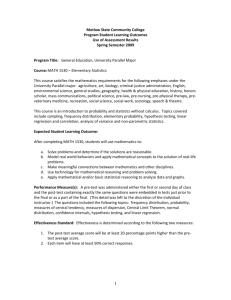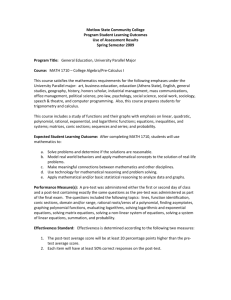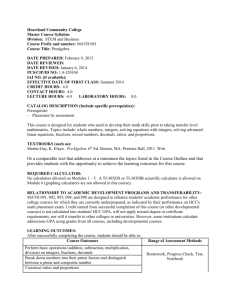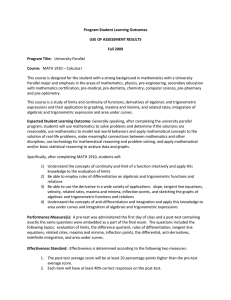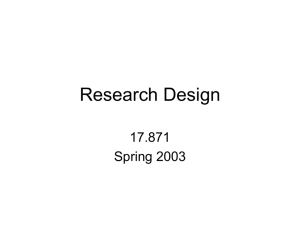MATH 1710 - Motlow State Community College
advertisement
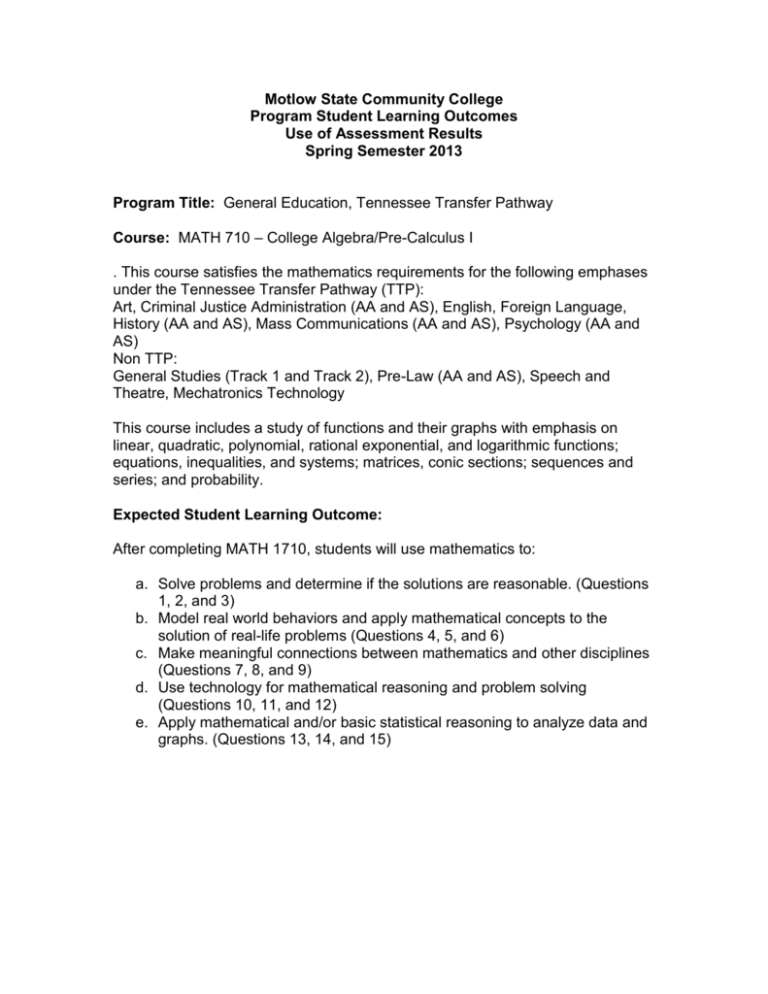
Motlow State Community College Program Student Learning Outcomes Use of Assessment Results Spring Semester 2013 Program Title: General Education, Tennessee Transfer Pathway Course: MATH 710 – College Algebra/Pre-Calculus I . This course satisfies the mathematics requirements for the following emphases under the Tennessee Transfer Pathway (TTP): Art, Criminal Justice Administration (AA and AS), English, Foreign Language, History (AA and AS), Mass Communications (AA and AS), Psychology (AA and AS) Non TTP: General Studies (Track 1 and Track 2), Pre-Law (AA and AS), Speech and Theatre, Mechatronics Technology This course includes a study of functions and their graphs with emphasis on linear, quadratic, polynomial, rational exponential, and logarithmic functions; equations, inequalities, and systems; matrices, conic sections; sequences and series; and probability. Expected Student Learning Outcome: After completing MATH 1710, students will use mathematics to: a. Solve problems and determine if the solutions are reasonable. (Questions 1, 2, and 3) b. Model real world behaviors and apply mathematical concepts to the solution of real-life problems (Questions 4, 5, and 6) c. Make meaningful connections between mathematics and other disciplines (Questions 7, 8, and 9) d. Use technology for mathematical reasoning and problem solving (Questions 10, 11, and 12) e. Apply mathematical and/or basic statistical reasoning to analyze data and graphs. (Questions 13, 14, and 15) Performance Measure(s): A pre-test was administered either the first or second day of class and the post-test containing exactly the same questions were embedded in tests just prior to the final or as a part of the final exam. (This detail was left to the discretion of the individual instructor). The questions included the following topics: lines, function identification, conic sections, domain and/or range, rational roots/zeros of a polynomial, finding asymptotes, graphing polynomial functions, evaluating logarithms, solving logarithmic and exponential equations, solving matrix equations, solving a non-linear system of equations, solving a system of linear equations, summation and probability. Effectiveness Standard: Effectiveness is determined according to the following two measures: 1. The post-test average score will be at least 20 percentage points higher than the pre-test average score. 2. Each item will have at least 50% correct responses. Assessment Results: 1) Assessment results showed a 32 percent point gain from pre-test to posttest, as the average of the pre-test scores was 23 and the average of the post-tests was 55. 2) Post-test data from item analysis, however, indicate that 53 percent or more of the 97 students (i.e. more than 50%) responded incorrectly to problems concerning asymptotes, rational roots/zeros, conic sections, probability and summation. Results of the pre-test were as follows: (97 students) Expected Student Learning Outcome a a a b b b c c c d d d e e e Question Number Number Missed 1 2 3 4 5 6 7 8 9 10 11 12 13 14 15 Number Correct 77 87 82 84 81 69 74 59 82 77 82 70 65 71 59 % Missed 20 10 15 13 16 28 23 38 15 20 15 27 32 26 38 79% 89% 85% 87% 84% 71% 76% 61% 85% 79% 85% 72% 27% 73% 61% % Correct 21% 11% 15% 13% 16% 29% 24% 39% 15% 21% 15% 28% 33% 27% 39% Results of the post-test were as follows: (97 students) Expected Student Learning Outcome a a a b b b c c c d d d e e e Question Number Number Missed Number Correct % Missed % Correct 1 2 3 4 5 6 7 8 9 10 11 12 13 14 15 49 40 35 44 30 28 36 24 54 33 46 25 17 19 29 48 57 62 53 67 69 64 73 43 64 51 72 80 78 68 51% 41% 36% 45% 31% 29% 37% 25% 56% 34% 47% 26% 18% 20% 30% 49% 59% 64% 55% 69% 71% 63% 75% 44% 66% 53% 74% 82% 80% 70% Change In Percentage Points +28 +48 +49 +42 +53 +42 +39 +36 +29 +45 +38 +46 +49 +53 +31 Ninety-seven (97) students took both the pre-test and the post-test. The average of the pre-test scores was 23% and the average of the post-test scores was 55%. Assessment results showed a 32 percentage point gain from pre-test to post-test, thus meeting the effectiveness standard that the post-test average score be at least 20 percentage points higher that the pre-test average score. a) The effectiveness standard that each item will have at least 50% correct responses on the post-test was met by all problems except problem 1 and problem 9, which involves finding asymptotes and probability. These involve SLO a (Solve problems and determine if the solutions are reasonable) and SLO c (Make meaningful connections between mathematics and other disciplines). Use of Assessment Results: The initial teaching of the items identified in the item analysis as needing improvement occurs in this course. Faculty are concerned that the question concerning asymptotes were still missed by more than 50% of the students on the post-test. More emphasis was to be put on this item to see if an increase in correct answers would be seen. This was not the case and faculty who teach MATH 1710 will be looking into online solutions that students can try. From the analysis reports from 2009 and 2013, we can see the following: MATH 1710 90 80 Average change in percentage 70 60 50 2009 2013 40 30 20 10 0 a b c Student Learning Outcome d e According to the chart above, the average change in percentage points in each learning outcome has increased considerably from 2009


